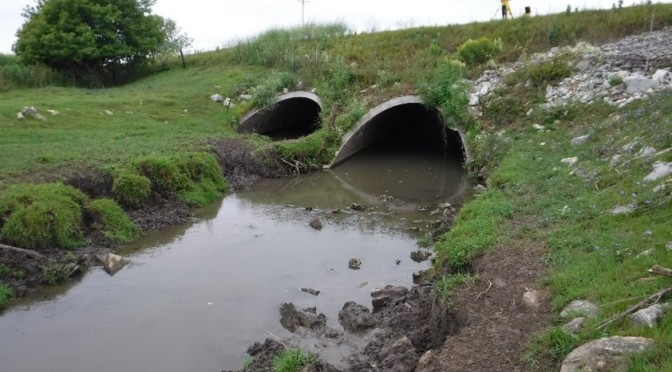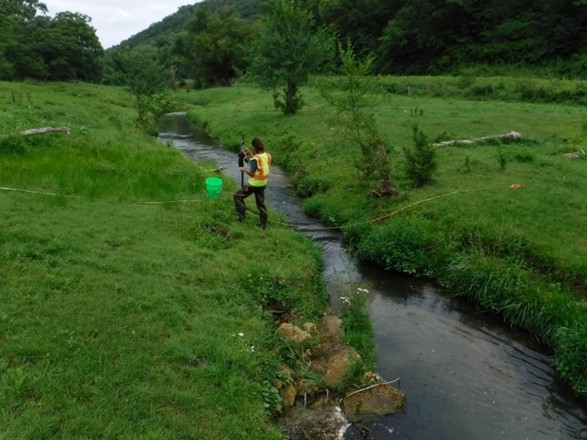Culverts that influence the speed, depth or flow of a natural waterway can have a detrimental impact on fish populations. By assessing sites across the state, MnDOT sought to identify the effects the culverts have on aquatic wildlife currently and project what potential flooding and drought scenarios could mean in the future.
At locations where roads and streams intersect, culverts can serve an important role in safely and effectively channeling flowing water beneath the surface of the roadway. However, in recent years Minnesota and other states have expanded the focus of their culvert designs, moving from primarily accommodating the needs of road users to considering the health, capabilities and habits of the organisms that live in the water as well.
“As good stewards of Minnesota’s public waterways, we aim to make these resources accessible and enjoyable for all users—and that goes for aquatic wildlife as well as for people,” said Erik Brenna, assistant state hydraulics engineer, MnDOT Office of Bridges and Structures.
The ability to travel freely is key for healthy fish populations; synthetic structures that restrict or affect the natural flow of a stream can become barriers to this movement and adversely affect vulnerable wildlife communities. For instance, culverts positioned at a slope greater than the stream can accelerate the velocity of the water at some points and overwhelm the abilities of some types of fish, while structures that are too wide, placed higher than the streambed, or lack rocks or sediment that provide crucial resting places can make water too fast and shallow for successful migration.
In 2019, MnDOT published guidance to help culvert designers in the state better understand and consider the unique characteristics of each site in order to construct more environmentally sensitive structures. The guide encourages stream connectivity, identifying practices for constructing and installing culverts that match the natural depth and speed of the water as it flows beneath the road from one side to the other. However, whether the practices effectively reduce barriers under current climate conditions and would be able to accommodate future changes has not been well-established.
What Was Our Goal?
This project continued previous MnDOT research by assessing existing culverts at sites around the state to assess whether fish and other aquatic organisms have the ability to pass freely through the culverts now, and identify challenges that may arise as climate change affects the intensity and duration of storms and corresponding water levels and flow rates in the future.
What Did We Do?
To ensure a representative sampling of culvert designs and aquatic habitats that could be applied to the entire state, researchers analyzed six types of culverts at 50 sites representing 10 watersheds across Minnesota. At each site, the research team collected data on the size and shape of the culvert, the dimensions and other attributes of the surrounding waterway, and the swimming capabilities of the different fish species inhabiting the area. By comparing the data, researchers could determine, for instance, whether the culvert affected the water’s velocity at a given point in the stream to exceed the abilities of a specific type of fish, presenting a potential passage barrier for that particular species.
Next, researchers used modeling software to estimate how future rainfall and runoff may affect a subset of the culvert sites. By applying projected climate data to five sites, researchers were able to simulate a variety of possible high- and low-flow conditions 40 to 60 years from now.
What Did We Learn?
The research provided additional support for the recommendations published in MnDOT’s 2019 culvert design guide. While the exact characteristics of each stream vary, culverts should generally be as wide or slightly wider than the banks of the stream at that location, match the slope of the streambed, and in some cases be embedded below the sediment to create habitat within the culvert similar to the stream across seasonal changes in water levels.
“This research showed that culverts designed according to Minnesota’s current guidance help to maintain stream connectivity even in future hydrologic scenarios,” said Jessica Kozarek, research associate, University of Minnesota St. Anthony Falls Laboratory.
Projecting future scenarios proved to be more challenging since potential air temperature, amount of precipitation, humidity rates and other variables can significantly affect how water is distributed across a region and flows in waterways. Future flow rates through culverts may include both increased peak flows during storms and reduced low flows between storms.
However, the researchers noted that while the simulation models showed a range of potential climate-based outcomes at each of the sites investigated, culverts constructed according to the guidance will be better able to mitigate the effects of changing water levels, making them more resilient to climate change than earlier designs and increasing the likelihood that streams will remain connected even as hydrologic conditions change in the future.
What’s Next?
With a better understanding of how culverts can affect fish and other vulnerable aquatic populations, designers across the state will be better-positioned to create structures that are sensitive to a stream’s local ecosystem and support connectivity throughout a range of climate conditions. These more conscientiously designed and constructed culverts tend to cost more upfront, but their longer life span and resilience in the face of climate-related uncertainty provide greater long-term value for the people and wildlife living in Minnesota.


